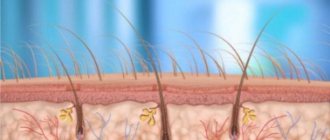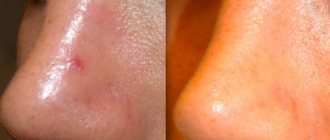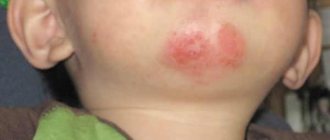Chin swelling causes
If swelling has formed in the chin area, this means the presence of one of the diseases - mumps, inflamed lymph nodes, dental problems, sore throat. The most common condition is swelling of the lymph nodes (lymphadenitis).
A lymph node is a collection of lymphocyte cells covered with connective tissue. Lymphocytes perform the function of producing proteins and protecting the body from the effects of viruses or infections.
Why does the lymph node swell?
Swelling and enlargement of the lymph node indicate the beginning of the inflammatory process. The main causes of inflammation are viral infections, colds and flu. There are also infections that have a bacterial and parasitic form.
They cause the main causes of inflammation of the lymph nodes, including those under the chin. In addition to the tumor under the chin, the lymph nodes become inflamed in the groin area, armpits, and neck.
Manifestations of lymphadenitis are caused by:
- headache;
- bulge in the chin area;
- throbbing pain;
- compaction;
- redness;
- putrefaction;
- temperature rise.
In what situations do lymph nodes become swollen?
Lymph nodes are capable of collecting lymph from certain areas of the body, so their swelling and enlargement indicate the location of the inflammatory process. The lymph nodes in the chin area are responsible for collecting lymph from the teeth, tongue and mouth.
The main factor that causes a swollen chin is an upper respiratory tract infection. The patient begins to sweat and the temperature increases.
The chin can also swell with a simple enlargement of the lymph node in the area of the lips and teeth.
Treatment of inflamed lymph nodes occurs by disinfecting the skin in the area of edema. The procedures can be carried out independently, if it is not possible, contact a specialist. Do not heat or apply compresses to the swelling.
What is a cervical tumor?
The appearance of swelling in the neck can be a factor in various diseases. This may be swelling of the lymph nodes in the neck caused by a sore throat or acute pharyngitis, colds or tuberculosis.
Symptoms of swelling may include:
If your neck is swollen and these symptoms are detected, you should definitely consult a doctor. Oncological diseases (leukemia, lymphoma) often occur, which cause swelling of the nodes. Cancer cells can easily spread to the lymph nodes, which leads to inflammation and swelling of the neck.
How to treat cervical swelling?
Usually, treatment eliminates the causes that caused the inflammatory process. If your neck is swollen due to a bacterial infection, then antibiotics are necessary. If cancer is suspected, surgery will be required.
Lip swelling
By swelling we mean the release of excess fluid into the intercellular space, the release of histamine and other active chemical and biological substances into the affected area.
Infectious course caused in hypertoxic form
Allergic reaction
Swelling of the lips occurs due to injury - during sports or household carelessness. As a result of the blow, a significant amount of blood flows out of the bloodstream into the affected area. This is why swelling occurs. A healing ointment must be applied to the swollen area.
To treat swelling on the lip, take anti-allergic and anti-inflammatory drugs, after consulting with a doctor. In addition to medications, you can use the method of cooling a swollen lip. To do this, apply ice or something cold to constrict the blood vessels so that they stop bringing in excess blood, which increases swelling.
© About swelling. The information posted on the site is the property of the site administration and is protected by copyright law. Copying information is possible only when placed with an active hyperlink to the source page.
What is lymphadenitis?
If swelling has formed in the chin area, this means the presence of one of the diseases - mumps, inflamed lymph nodes, dental problems, sore throat. The most common condition is swelling of the lymph nodes (lymphadenitis).
A lymph node is a collection of lymphocyte cells covered with connective tissue. Lymphocytes perform the function of producing proteins and protecting the body from the effects of viruses or infections.
Lymph node locations
- Occipital. They are located in the area where the neck meets the skull.
- The popliteal lymph nodes are located at the back, on the surface of the knee joint.
- The inguinals are located in the inguinal folds.
- The lymph nodes of the mediastinum are located in the chest cavity. This location is considered one of the most dangerous, since vital organs are nearby: heart, lungs, trachea.
- Axillary lymph nodes are located in the armpits. Their number constitutes a fairly powerful group of lymphatic tissue, which filters about 70% of lymph.
- The parotid can be located in front or behind the auricle.
- Facial lymph nodes are usually located on the lower jaw, cheek and chin.
We invite you to read Metrogyl® instructions for use
They are also found in the area of the nasolabial folds, eyes and facial muscles.
Swelling of the chin: causes of swelling
Sometimes a small swelling under the jaw suddenly forms, this is possible for many reasons, and oncology is one of them. But often, if the swelling has recently formed, there is no need to worry too much, since cancerous tumors take longer to develop and are more noticeable. You need to calm down and figure out why your chin is swollen.
Causes of swelling under the chin and their symptoms
Chin swelling is not an independent disease, but a symptom of a pathological process in the body. Most often this can be caused by:
Lymphadenitis
Swelling in this disease is often provoked by a viral infection that has entered the lymph nodes. It can also be caused by harmful microorganisms (bacteria) entering the body.
With this disease, a person also experiences a number of additional symptoms, which include:
- Increased body temperature
- Pulsating pain
- Tissue compaction, swelling under the chin in the center,
- Skin redness,
- General weakness.
Important! The most likely infectious diseases that provoke a tumor under the chin: tonsillitis, streptococcal or staphylococcal infection, tonsillitis, laryngitis, purulent tooth abscess, alveolitis, otitis media, sinusitis, chicken pox, mumps (mumps), measles.
Lipoma formation
The causes of this complication are still not fully understood and unknown. This tumor consists of fatty tissue that has begun to grow uncontrollably. It is soft, mobile and painless to the touch. In the initial stages, it can be removed without any consequences. Otherwise, when enlarged, the nerves will be pinched, and the affected area will begin to hurt.
Fibroma
A formation similar to the previous one, causing a condition in which the chin is swollen. The only difference is that fibroma consists of connective tissue, is dense to the touch and does not cause pain.
Atheroma
Subcutaneous infiltrate, which is a clogged sebaceous duct. Dense and does not cause pain in the first stages. However, with its, albeit slow, growth, it can begin to fester and become inflamed.
Allergy
Swelling of the chin and lower lip or upper lip can be caused by an allergic reaction. Distinctive features are a fairly large area of edema and the absence of pain. Allergens that provoke this condition can be: citrus fruits, chocolate, seafood, medicines, cosmetics, pollen.
The appearance of a subcutaneous pimple
One of the most common causes of swelling on the chin. It manifests itself due to blockage of the sebaceous glands; such compaction often hurts greatly upon palpation.
This problem can cause swelling under the chin in all areas (center, side, back of the neck, etc.). This disease takes a long time to develop and in the early stages can be treated, which is more likely to be successful. If you notice some kind of formation that is slowly increasing, consult a doctor immediately to avoid fatal consequences.
Important! Problems caused by malignant tumors develop over a long period. If you find a tumor on your chin and lower lip, which appeared in a short time, then with a high degree of probability this is a benign neoplasm.
Treatment of diseases that cause swelling under the chin
If you have swelling and pain under your chin, you shouldn’t try to guess what is causing this condition. Consult your doctor for advice. The treatment of each individual case has its own characteristics.
Surgery
Swollen areas are often dealt with through surgery; it is used when the swelling is caused by:
- Lipoma. Removed using laser. In the initial stages, you can get rid of it without making a cut or leaving any residual marks. However, due to the fact that this disease does not cause physical discomfort in people, they do not go to doctors for a long time, as a result of which, due to the large size of the tumor, scars remain. Treatment with folk remedies is allowed for use only after consultation with a specialist, and if the size of the tumor is small, it does not pose a threat to vital parts of the body,
- Fibroma. There are five methods for removing fibroids: cryodestruction, electrocoagulation, laser destruction, surgical excision, radio wave surgery. The method is determined by the attending physician based on the size of the formation and the patient’s condition.
- Atheroma. The most common types of surgical intervention are: laser destruction, surgical excision, radio wave surgery.
Eliminating the infection
Diseases such as lymphadenitis are treated by eliminating the source of inflammation. This is taking antibacterial or antiviral drugs (depending on the type of infection).
Subcutaneous pimples generally resolve on their own. However, if the affected area turns red and begins to become inflamed, seek advice. In this case, folk remedies can be used immediately.
A medicine such as Levomekol is often used. It combines antibacterial and anti-inflammatory functions. Apply to the swollen area of the chin at night.
Allergen identification
In case of an allergic reaction, it is important to identify and eliminate the allergen that caused swelling on the chin and lips, this will significantly improve the patient’s condition. Additionally, you can take, in accordance with the instructions, an antihistamine (Suprastin, Diazolin, Loratadine).
Folk remedies
When the chin is swollen, surgery is often resorted to. This suggests that using home remedies may be dangerous to the patient's health. However, if the attending physician considers this acceptable, then the following recipes can be used:
Tea tree oil
It will help in removing subcutaneous acne that causes swelling under the chin. To do this, you need to apply this product to the affected area every 3-4 hours, it will dry the skin and relieve inflammation.
Lotions from a series
Pour 2 tablespoons of dried string with 500 ml of boiling water, leave for 30 minutes. Soak cotton pads in the resulting solution and apply to the problem area for 5-10 minutes. The therapeutic effect will be stronger if this remedy is used in combination with medications prescribed by a doctor.
In order not to find areas of your chin and neck swollen, you should always monitor hand and oral hygiene, since viruses and bacteria often enter our body in this way, which causes inflammatory processes. Swelling in the neck and chin often requires precise drug therapy. Be sure to consult a doctor, do not self-medicate.
Loading…
Source: https://athletic-store.ru/otek/prichiny-oteka-podborodka
Video: How to cure enlarged lymph nodes
In more severe cases, it is necessary to resort to antibiotics and even surgery to open the node and pump out the pus that has accumulated there.
In many parts of the human body there are lymph nodes that can become inflamed due to infection, which they are a barrier to. There are about 150 groups of these organs. Lymph flows through them, arriving through lymphatic ducts from other organs and parts of the body. The node itself is an elastic, soft, kidney-shaped formation. It has a pinkish tint and a size of 0.5-50 mm. The organ is part of the peripheral immune system. Different lymph nodes on the human body are responsible for a specific area of the body.
What does a tumor under the chin mean?
A lump of swelling under the chin that appears suddenly indicates compaction of the epidermal tissues or excessive accumulation of fatty tissue.
If a dense nodular lump has formed around the chin, this does not necessarily mean that the nature of the origin of this neoplasm is necessarily malignant.
It is quite possible that the tumor is benign and developed under the influence of certain pathogenic factors present in a person’s life. With timely treatment, the occurrence of a full-fledged cancer tumor can be avoided.
What could it be - the causes of a tumor on the chin
If the development of a tumor under the chin occurred suddenly, then this is not a reason to sound the alarm.
Most likely, this is a peculiar manifestation of local inflammation and an internal pimple with a purulent pustule has formed in the subcutaneous layer, formed as a result of penetration of a pathogenic infection into the skin.
Also, the appearance of a lump under the chin that resembles a tumor may be due to the following reasons.
Lipoma
Popularly, a lump of this nature of origin is called a wen. This is a truly benign neoplasm, which consists of excess accumulation of fat in the subcutaneous layer. Due to the fact that fatty tissue accumulates in the same segment of the epithelial cover, a compaction is formed and the fat clot resembles a tumor body.
Lipoma is practically unable to transform into a malignant formation, therefore it is considered safe for the human body. Most of all, it brings aesthetic and psychological discomfort. The danger comes from the wen, which has begun to turn red, inflamed and painful.
This is a clear sign of the development of a pathological condition of adipose tissue and surrounding tissues of the epidermis.
Folliculitis
This is inflammation of the hair follicle. In women, this disease is rare, but is still periodically diagnosed in medical practice. Ladies who have excess hair in the chin area are susceptible to the disease.
As a rule, women aged 45 years or more are at risk.
Hormonal changes in the body lead to the fact that even the smallest hair follicles cease to receive the required amount of nutrients and this leads to their inflammation as a result of the pathological process in the follicle.
Where the hair follicle is located, sanguineous fluid and purulent contents begin to accumulate. These biological fluids form a kind of pustule, which upon palpation resembles a tumor.
The formation is dangerous because inflammation and swelling of tissues can spread to the larynx area and affect the respiratory tract.
If, in addition, a bacterial infection of the inflamed follicle occurs, the consequences for the patient’s health can be very sad, and the treatment can be lengthy using potent antibacterial drugs.
Skin cyst
In dermatology, this neoplasm is called an epidermal cyst. It occurs in the chin area due to metabolic disorders in epithelial cells. In the future, this leads to the appearance of small voids in the surface layer of the skin.
This is considered a deviation from the normal state of the skin and the body fills the voids with keratinized particles of the epidermis, which in their structure resemble fibrous tissue. As a result of this, a dense knot is formed under the chin, which, upon palpation and visual inspection, in all its characteristics resembles a dense lump.
Quite often, a skin cyst has a bluish tint, which is associated with an effect on the smallest vessels, capillaries, and a violation of the venous outflow of blood in this part of the body.
Malignant tumor
The most terrible and dangerous diagnosis, indicating the development of an oncological process in a person. This reason for the presence of a lump in the chin area is provoked by negative factors present in the patient’s life, which provoked the degeneration of previously healthy epithelial cells and the formation of a tumor.
If treatment was started at stages 1-2 of cancer development, then the prognosis for recovery is quite high.
At later stages, the process of metastasis begins and, at first glance, a very harmless chic produces millions of malignant cells into the blood, capable of forming similar tumors in any part of the sick person’s body.
Abscess
If pyogenic microbes enter the skin in the chin area, acute inflammation of the deep epidermal tissues occurs.
As a result of this, the patient observes a rapidly increasing lump under the chin, which is painful, swollen, and the surface of the skin has a red and inflamed appearance.
Most often, a lump under the chin of this nature occurs as a complication after suffering a sore throat with bacterial damage to the mucous membrane of the throat due to a streptococcal infection, or the presence of chronic tonsillitis in the patient.
The latter disease in most cases is provoked by invasion of the tonsils by a strain of Staphylococcus aureus. This biological agent very often affects epithelial cells in the area of its localization.
As the purulent contents mature, the lump in the form of an abscess becomes soft and if it has not been surgically removed, the skin is able to cleanse itself by breaking through the infectious tumor with the release of purulent contents.
Treatment - what to do with a lump on the chin under the skin that hurts?
The first thing a patient should do if he discovers a nodular tissue compaction resembling a tumor on his chin or under it is to contact a medical institution at his place of residence, or the nearest clinic.
It all depends on the general well-being of the person. Therapy for the neoplasm is based on the presence of which particular disease caused the formation of a lump in the subcutaneous layer.
Treatment may include the following procedures:
Antiseptic therapy
The presence of a purulent pustule inside the lump, formed as a result of the formation of an infectious abscess, requires the use of antibacterial drugs that suppress the activity of the bacterial pathogen.
Tablets and intramuscular antibiotics are used in the form of injections. The type of drug is determined solely by the attending physician, based on what type of infection was detected during laboratory testing.
As the bacterial population decreases, inflammation goes away, and the lump acquires a soft structure and gradually resolves.
Warming up
In some cases, patients with a lump in the chin area are shown electrophoresis to warm up areas of the skin in order to speed up blood circulation in the epithelial tissues and prevent the re-formation of a benign tumor. As a rule, this element of therapy is used in the treatment of epidermal cysts.
Surgery
A universal and conservative method of treating tumors of all types formed in the chin area.
Surgical intervention involves performing a local strip operation with dissection of the skin and mechanical removal of wen, abscesses, cysts and other foreign formations that were found in the surface layer of the epithelium.
The method is really effective and allows you to avoid relapses of the disease, but it traumatizes the skin, and the healing time for the suture can be from 2 to 3 weeks.
Chemotherapy and cytostatics
If a patient is diagnosed with a malignant tumor under the chin, which really threatens his life, doctors develop a comprehensive therapeutic protocol, which includes surgical removal, radio wave irradiation and physiotherapy. A key element in the course of treatment is the use of chemicals that kill cancer cells and reduce the size of the tumor. They also do not allow the malignant neoplasm to spread its metastases throughout the body.
The disadvantage of chemotherapy is that the toxic substances contained in drugs in this category kill not only cancer cells, but also destroy healthy tissue of vital human organs.
Therefore, cancer patients feel very bad after undergoing another course of chemotherapy. Treatment with cytostatic drugs allows for a targeted effect on tumor cells without harming other tissues.
Cytostatics are new generation drugs that allow you to remove a malignant lump under the chin without harming the overall health of the body.
Possible complications if the lump is not treated, which doctor should I contact?
If you find a lump under your chin, this tumor cannot be ignored. You should immediately seek help from a surgeon. Foreign external and subcutaneous formations, regardless of their nature of origin, are the domain of a specialist in the field of surgery.
The doctor will conduct a visual examination of the tumor, palpate it, and then write a referral for tests. Having received data on the patient’s health condition, the doctor will be able to prescribe appropriate treatment.
In the absence of proper therapy, complications such as:
- inflammatory swelling of the larynx with the onset of suffocation;
- sepsis caused by infection in the blood, lymph and bone marrow;
- development of the tumor up to stage 4 with the spread of metastases throughout the body and imminent death;
- compression of blood vessels with disruption of local circulation.
There are many options for complications of the clinical picture of the disease, depending on the etiology of the lump and how long it has been present in the subcutaneous layer of the chin area.
Source: https://furunkul.com/opuhol/shishka-pod-podborodkom-poseredine.html
Groups of lymph nodes
The lymphatic system has a branched structure, which consists of a network of large vessels, along the path of which nodes are located. They can be found throughout the body in its most important parts. Lymphatic vessels and nodes accompany blood capillaries everywhere. The latter, depending on the location scheme, are divided into:
- parietal, located in the walls of cavities;
- visceral, which are located near the internal organs.
Also, the nodes of the lymphatic system in the diagram are divided into smaller groups, also depending on the location of the lymph nodes. Based on this principle, nodes are determined:
- upper extremities (axillary, elbow);
- heads (deep and parotid superficial, submandibular);
- chest, including visceral, flowing into the thoracic duct (upper tracheobronchial, bronchopulmonary, lower tracheobronchial, anterior and posterior mediastinal) and parietal (periosternal, intercostal);
- necks (anterior cervical, superficial and lateral deep);
- pelvis (sacral, internal iliac, external and common iliac);
- lower extremities (superficial and deep inguinal, popliteal);
- abdominal cavity (hepatic, gastric, mesenteric-colic, celiac).
Lump on the chin under the skin - the lump hurts
The appearance of swelling in the facial area is not only a cosmetic defect, but also a symptom of a malfunction in the body. A lump on the chin occurs due to various reasons and provoking factors.
Often patients panic, believing that it is an oncological tumor. This possibility exists, but the tumor also appears due to another etiology that is not related to cancer processes in the body.
Let's consider why swelling appears on the skin and what it could be?
Lump under the chin
An internal lump on the chin under the skin appears as a neoplasm that may appear suddenly. In the evening a person falls asleep without having problems with the skin, and in the morning he discovers a cosmetic defect.
Most often, the location of the pathological element is under the lower jaw or in the occipital region. It is there that the lymph nodes are located, which tend to increase due to existing inflammatory processes.
In case of viral, infectious and bacterial pathologies, activation of these nodes is observed, as a result of which they become larger. The lymphatic system in the human body acts as a kind of filter that prevents inflammation from spreading throughout the body.
Advice: When a lump in the chin area feels hard, stiff and extremely painful, it is recommended to immediately consult a doctor. These signs indicate a developing tumor, which, unfortunately, is not always benign.
Note that if the lump appears within a few days or even a couple of hours, then there is no need to panic, it is definitely not cancer. Oncological compactions develop gradually and relatively slowly, and other negative signs are always observed.
Why did a lump appear on the neck under the chin?
There are many lymph nodes in the human body, including those located under the lower jaw. They support the functioning of the immune system. In case of pathological processes in the body, they try to neutralize them.
From a medical point of view, to identify the cause of abnormal swelling of the node, you need to look for a disease. Usually the cause of the occurrence lies in pathologies of the upper respiratory tract, sometimes in dental problems.
Often the cause is severe sore throat, tonsillitis or pharyngitis. The inflammatory process tends to intensify due to the lack of adequate treatment, smoking and drinking alcoholic beverages.
The compaction under the skin can be leveled out on its own if the immune system effectively fights pathogenic agents. When the immune system is weakened, the alarming symptoms will intensify.
If a lump appears under the chin, then the reasons are conditionally divided into two groups:
- Nonspecific etiology is caused by the penetration of pathogenic microorganisms, viruses and bacteria, which led to an inflammatory process in the lymph node. These may be pathologies of the oral cavity, gingivitis, stomatitis, etc. In children - rubella, measles, mumps;
- Specific pathogenesis is based on pathogens - syphilis, tuberculosis, brucellosis. If in the first case the lump does not hurt, then in this version there is noticeable pain. Causes – lymphoma (tumor neoplasm of the lymphatic system), oral cancer, pharyngeal cancer, etc.
It is worth knowing: at an advanced stage of development, any oncological process in the body can become a provoking factor, which leads to an increase in peripheral organs in the lymphatic system.
The first signs of cancer and benign tumors
If a lump appears on your chin, you should visit a doctor. You won't be able to solve the problem on your own. Ignoring an obvious symptom and other characteristic signs can cost the patient’s life.
Signs of a benign neoplasm: the lump at the bottom of the chin is soft and mobile to the touch; upon palpation, slight discomfort or severe pain may be felt. In the latter case, the symptom indicates severe inflammation.
Symptoms of a compaction of a malignant nature include a hard neoplasm to the touch, it is not mobile, as if it is growing “inside” the face, there is severe pain in the absence of touching the pathological element.
Who should I contact if I have a lump under my chin?
When a lump appears in the facial area, and the tumor does not go away on its own, but on the contrary, alarming symptoms appear - pain, increased body temperature, headache, general malaise, etc., you definitely need to consult a medical specialist.
First of all, you need to visit a therapist and tell him about your problem. The doctor, after conducting a visual examination, will prescribe diagnostics, laboratory tests, or immediately give a referral to another highly specialized doctor if he suspects some pathology of his specialization.
If a malignant neoplasm is suspected, an oncologist is needed. If this is atheroma, then consultation with a surgeon is required. In a situation where the cause lies in a dental disease, visit the dentist. Depending on the etiology, treatment can be carried out by a hematologist, endocrinologist and other doctors.
A lump on the skin under the chin, accompanied by pain, should be seen by a doctor. As practice shows, an element can be harmless, for example, atheroma, or seriously threatening not only health, but also life - a malignant tumor.
Source: https://IDermatolog.ru/piodermiya/furunkulez/na-podborodke-shishka-i-bolit.html
Problems in the groin
In addition to the lymph glands behind the knee, women and men have nodes in the groin area on their legs.
We invite you to familiarize yourself with Chronic bad breath: causes and solutions.
The location of the inguinal nodes is in clusters on the sides of the pubic bone, slightly higher. They can only be found in an inflamed state, when they are swollen
Particular attention should be paid to the rapid detection of large, dense formations that do not move under the fingers. Then immediately see a doctor, as it may be a tumor.
There are cases when, when a malignant tumor forms, there is no pain for a long time.
The lymph nodes under the knee are smaller in size than the inguinal ones. However, they help the inguinal nodes fight infection in the fingers, feet, calves, and thighs.
Lump under the chin: 3 alarming reasons for its appearance
A lump under the chin can be a manifestation of various health problems. They can only be avoided through preventive measures, including regular medical examinations (at least once a year), proper nutrition, giving up bad habits and taking vitamins to maintain the body’s immune system.
Sometimes small lumps appear under the skin on the neck, which cause numerous fears in people who immediately begin to associate these lumps with cancerous tumors. However, such formations are not necessarily cancerous.
The latter form gradually and are characterized by specific symptoms, while a lump under the chin can appear suddenly - in just one night. However, determining the causes of its formation is an important step towards its elimination.
There are three main reasons for the formation of lumps under the skin , each of which needs to be discussed separately:
- Inflammation of the lymph nodes due to infectious or viral diseases.
- Formation of an internal pimple.
- Development of oncology.
A therapist will help determine what is causing the problem. Based on the circumstances that led to the appearance of an internal formation in the neck, he gives a referral to a doctor specializing in the treatment of specific groups of diseases. He, in turn, prescribes a suitable method for eliminating the resulting compaction.
A lump under the chin as a sign of lymphadenitis
Lymph nodes perform an important function in the human body, supporting the functioning of its immunity. It is here that a large number of immune cells are concentrated, which are activated during the invasion of any type of infection or virus and strive to neutralize them.
Subscribe to our INSTAGRAM account!
However, these cells do not always have the strength to delay infection; its pathogens can penetrate inside the lymph node, as a result of which the latter becomes severely inflamed and enlarges. This phenomenon is called “lymphadenitis”. With the help of inflammation of the nodes, the body signals the presence of problems with the functioning of the immune system.
To understand that the cause of the compaction under the skin lies precisely in lymphadenitis, the doctor must detect the diseases that triggered the inflammation.
Usually their list comes down to the following options:
- dental diseases: dental granuloma, gumboil, phlegmon;
- diseases of the throat and upper respiratory tract - pharyngitis, sore throat.
With lymphadenitis, a lump appears on the right or left under the lower jaw. The accompanying signs of this disease, in addition to increasing compaction, include the following symptoms:
- Body temperature rises.
- The throat and the lump itself are very sore.
- Your health worsens and you feel constant weakness.
- The formation on the neck is dense to the touch, hot, and not fused with the surrounding tissues.
- The skin around the inflamed lymph node may turn red - this means that lymphadenitis has turned into a purulent form, requiring mandatory medical intervention.
Often the inflammation goes away on its own, and the lymph node reaches normal size. However, this does not mean that treatment can be neglected . Contacting a specialist is necessary: this will help avoid various complications of the disease.
Lump on the throat under the chin: symptoms of a tumor
Sometimes the compaction under the skin is still due to the appearance of a tumor . In this case, both benign and malignant formations are possible. They are easy to distinguish from each other by touch.
If a lump under the chin can move under the finger, grows gradually, and does not hurt, then most likely it is a consequence of a benign tumor of the salivary gland. It is formed when the latter becomes clogged and inflamed.
If the seal is immobile and closely adheres to the surrounding tissues, there is a risk of developing cancer. In this case, the lump hurts a lot, the person’s general condition worsens: there is a feeling of numbness and weakness. The voice often changes: it becomes hoarse.
A lump on the chin under the skin is a painful pimple
Internal acne is a fairly common occurrence and can be explained by many factors, including poor diet and problems with the gastrointestinal tract. On the face, they can form on the forehead, cheeks and chin. Unlike ordinary acne, internal acne does not occur on the surface of the skin, but much deeper - in the dermis.
In this case, the lumps are rarely noticeable to the eye, but are easily felt when you touch them with your fingers: pimples can be very large in size, even with light pressure they hurt.
If the lump appears due to a subcutaneous pimple, then it cannot be eliminated until the body itself copes with the problem.
It is strictly forbidden to try to squeeze out a pimple: being too deep, its core will not be able to break through the top layer of the skin, but will easily destroy the internal tissues.
Then the pus will spread under the skin and provoke the formation of new acne.
Inflammation of the submandibular lymph node: treatment, causes of lymphadenitis, what to do at home
This process can develop on one side of the jaw or on both sides at the same time. If the lymph node on the right side of the neck under the jaw is inflamed and painful, this may indicate a disease of the ENT organs.
In the jaw area there are 3 lymph nodes - the right and left submandibular and mental. The submandibular nodes can be palpated even in healthy people and may be enlarged, but not painful on palpation.
Normally, they are elastic, not fused with the surrounding tissues, the skin over them is not changed, and the local temperature is not increased. It is difficult to palpate the lymph node under the chin; this is only possible if it is enlarged due to pathology.
We suggest that you familiarize yourself with Pain-relieving dental gel for children during treatment
If a person has a cold, the lymph nodes under the jaw will immediately react and become inflamed. However, after recovery, they should decrease again. If this does not happen, the problem of their inflammation is much more global.
Symptoms
Enlarged lymph nodes are considered normal and are not accompanied by fever, pain when pressed, discomfort or loss of appetite. In the absence of these symptoms, the inflamed node simply works more actively than others due to a recent infection. This condition gradually passes. More dangerous symptoms for which you should consult a doctor are:
- pain when pressing on the node;
- malaise;
- decreased appetite;
- constant severe enlargement of the lymph node;
- restless sleep;
- elevated temperature;
- headache;
- chills;
- redness of the node.











